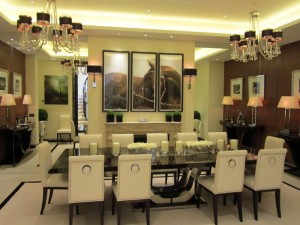When designing a room layout, colour scheme, lighting and furniture all will ultimately be affected by size. The most basic example of this would be that if you have a room that’s a corridor and only two meters wide you can’t put an armchair in, as it will take up the entire hallway whichever way you put it! Whilst a basic and obvious example it does portray the basic rule that if you can’t comfortable walk to an area of your room that will need to be accessed, all you need is meter wide path, then you need to either move some furniture about or get rid of something as you’re most likely unnecessarily filling your room and not allowing the rest of the furniture to be seen and appreciated. Of course the situations changes if the rooms main use if for practical work such as a garage but even then you need to be able to access tools and you will require some good cool white LED panels or LED tubes so you can see clearly should you want to use it as a workshop.

But there is a lot more to layout than this, but I’m not able to cover it as extensively as I would like, so I recommend you go read another article that’s more specific on that subject, but in all honesty layout really comes down to what suites you and furniture is relatively easy to move so it’s no problem re-adjusting if you don’t like the layout. Wall colouring comes at the other end of this scale, as it not only requires you to move all your furniture away from the walls anyway but it’s simply hard work, and costly to hire on a small scale property. But it needs to be done and it is so much easier to do early on when the other items are not in place, simply due to the nature of the task. The other key aspect on the layout is lighting and this can invariably mean the introduction of architectural LED lighting or if you have a tradition design scheme then a crystal chandelier is often an excellent idea.
I am sure we have all heard of the basic concept that light colours make a room feel larger whilst darker colours make it feel smaller. If you have not, then well now you have. Whilst simple, this is your bread and butter basic size to colour design tip to keep in mind at all times when colouring a room. Another effective technique that ties into this is using dimmable light bulbs to make a room darker or lighter to change how large it feels. Just make sure to be wary of CFL bulbs, as they are prone to having lower quality dimming. Yet filament bulbs work fine, and I find that LED energy saving light bulbs work the best due to the greater variety of different light colours available with them. The additional benefit is that you will be playing your part in improving the environment for future generations.
As a final point, you can also use texture to make a room feel smaller, which can be very effective when you do not want to sacrifice colour scheme yet change how spacious your room feels. When it comes to size and interior design, that’s pretty much all I got on this subject. All there is left to say is good luck!
Leave a Reply